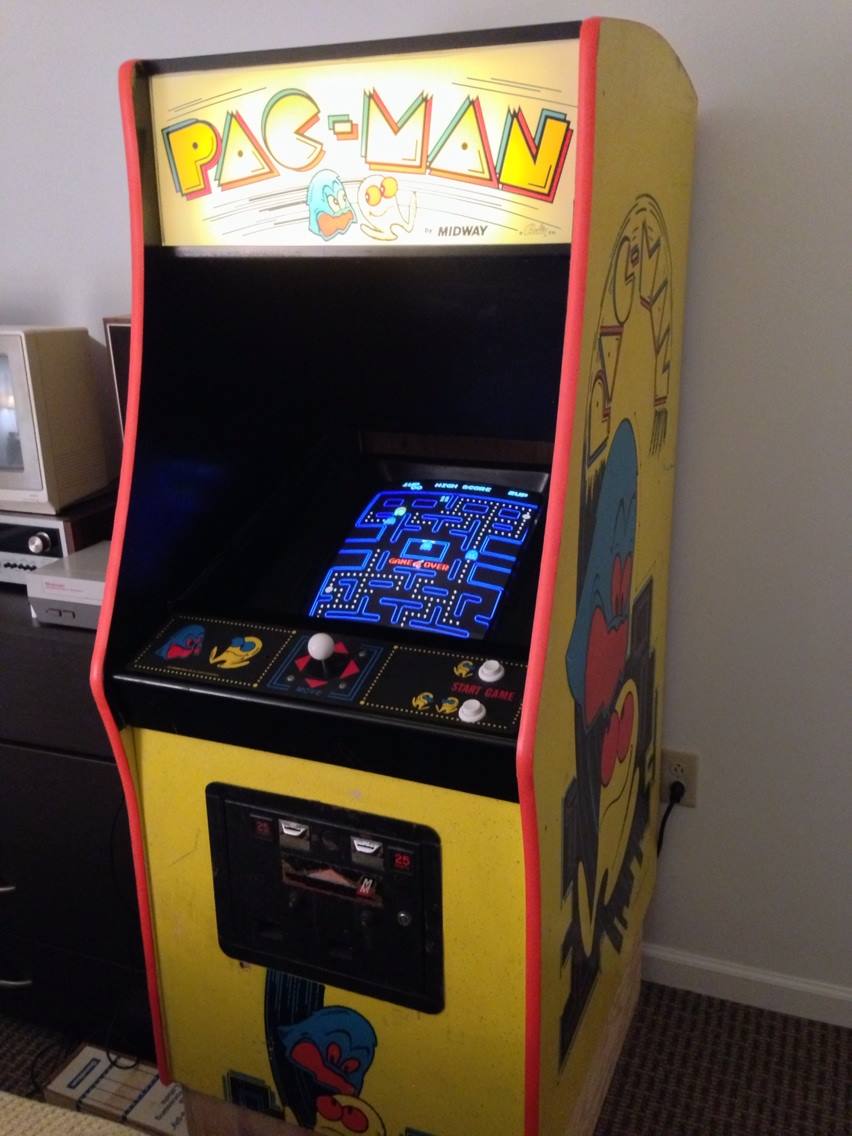About a year ago I visited a local arcade op's storage in search of a project cabinet. There were some nice choices about, but the one I left with was a lot more beat up than I expected it to be. It was a stripped Pac-Man with substantial water damage on the bottom. The bottom ~5" or so were completely gone, and the line of damage wasn't very straight or clear.
The cabinet hardly sat up straight, so it had to be leaned up in this corner.
You can see the floor tiles through the cabinet. Pretty much nothing is left inside, except one part of the monitor bracket.
The top wasn't so bad. A little swelling and plenty of old dirt, but it cleaned up pretty okay. A before picture:
What drew me to it is the art, though. The graphics on the side are still the original factory paint, and they look very good. I do not think the cabinet was in the sun very much. The usual hand marks aren't there on the sides, which is unusual for Pac-Man (players tend to rest one hand on the side while playing with the other.)
The first thing I did was cut down the bottom. I accepted that some art would have to go in order to make this a relatively straight cut. Using the circular saw, the cabinet was reduced a little in size. The plan was to make a pedastal that sat inside to raise the cabinet up roughly to the correct height.
After that, it sat up straight. After cleaning, T-molding was the first install. I already had a monitor (junked and fixed from an old project) and a PCB. A little bit of parts hunting on eBay and KLOV got me a control panel, marquee, monitor brackets, speaker grille, and an old Midway coin door. The panel is actually for Ms. Pac-Man, but it curiously had Pac-Man art on it. The seller wasn't sure. The original mounting brackets are gone so it's not mounted the way it originally used to, but it's solid and will work fine. The joystick is a 4-way Sanwa stick.
Here's the machine, just missing the monitor glass and a paint job for the pedastal:

Finally, I arranged a trade with a KLOV member for the original monitor glass. After painting the pedestal, here we are:
But hey, I promised a dual boot mod! EPROM burning is annoying, with the erasing and finicky programming voltage. These old games have lots of tiny ROMs, but in 2015 it's not too expensive to just replace many ROMs on the same address space with one larger 5V-tolerant parallel FLASH ROM, easily programmed in a few seconds over USB. Some 29F010 FLASH roms are used to replace the four and two rom sets on the CPU and graphics section of the game boards. Pac-Man's four chips are mapped in order, so they are just concatenated to provide a single ROM image to throw on the FLASH rom. The missing upper address lines and chip select signal comes from various points on the board I've forgotten about (some research into similar mods will have people reporting various places which all work). The same principle was applied to the graphics ROMs, though that's even easier since /CE can just be tied low.
These FLASH roms are far larger than the game, so there are many banks usable for switching to other games. In this case, I'm just switching between Pac-Man and Ms. Pac-Man using the highest address line. More games could be switched using a counter, or multiple switches. I think Pengo can be run on this hardware as well. Some glue logic checks for a falling edge on both player start buttons, and will reset the machine and swap banks when both buttons are pressed.
Using a hex editor, I NOP'd out the various routines and loops used in the game's boot sequence, so the checksum and flashy hardware test are bypassed. This is to let the games switch instantly without having to wait. In addition, a little Computer Science House logo / message has been put in both game's title screens.
Fun bonus hack: Since Ms. Pac-Man is a binary hack of Pac-Man, most of the game logic's routines are laid out the same, and the game state is stored in the same memory locations, so you can switch banks in the middle of a game and play Pac-Man in Ms. Pac-Man's maze or vice versa. The game logic and sound effects switch over, but the maze stays until you die. It's an interesting personality disorder to give a game!
Back to main index